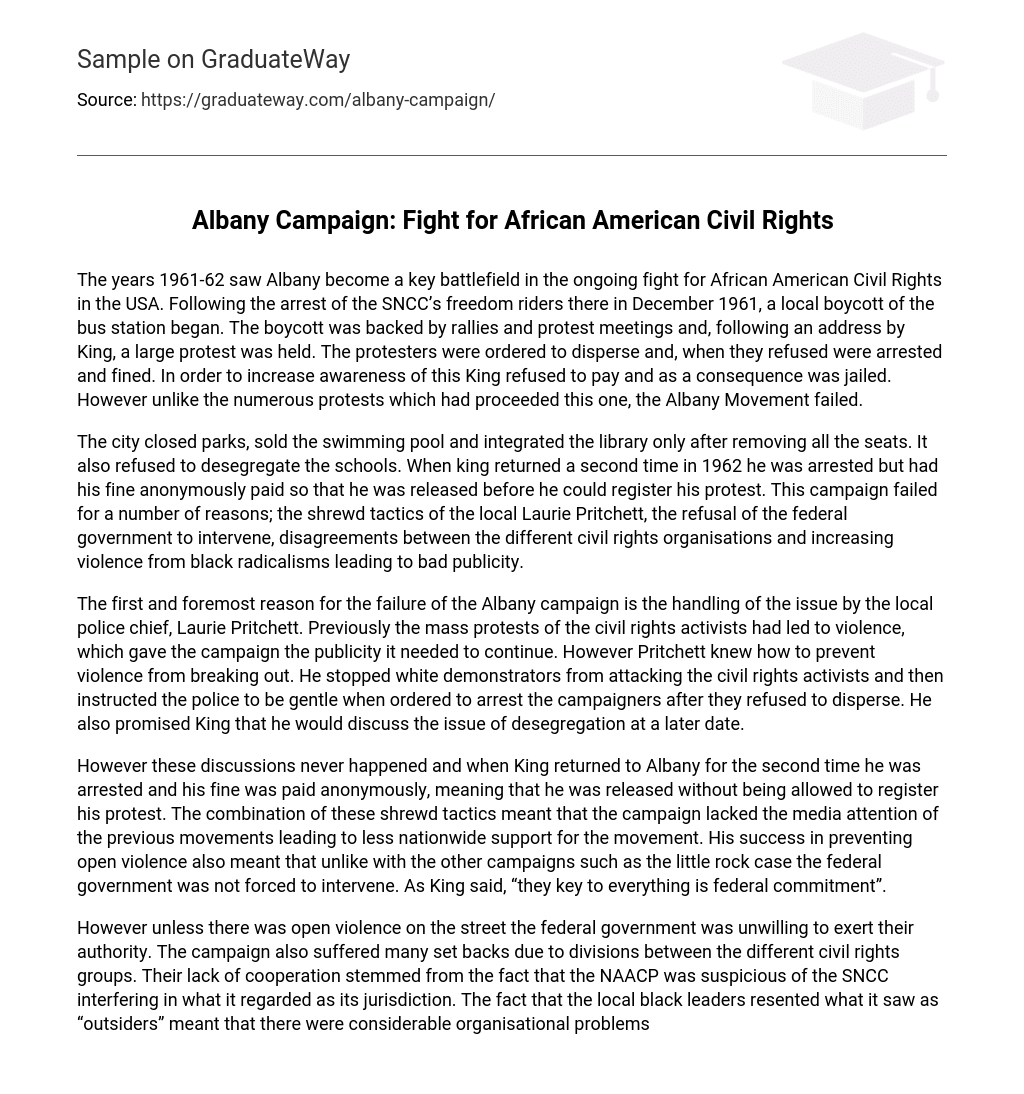The years 1961-62 saw Albany become a key battlefield in the ongoing fight for African American Civil Rights in the USA. Following the arrest of the SNCC’s freedom riders there in December 1961, a local boycott of the bus station began. The boycott was backed by rallies and protest meetings and, following an address by King, a large protest was held. The protesters were ordered to disperse and, when they refused were arrested and fined. In order to increase awareness of this King refused to pay and as a consequence was jailed. However unlike the numerous protests which had proceeded this one, the Albany Movement failed.
The city closed parks, sold the swimming pool and integrated the library only after removing all the seats. It also refused to desegregate the schools. When king returned a second time in 1962 he was arrested but had his fine anonymously paid so that he was released before he could register his protest. This campaign failed for a number of reasons; the shrewd tactics of the local Laurie Pritchett, the refusal of the federal government to intervene, disagreements between the different civil rights organisations and increasing violence from black radicalisms leading to bad publicity.
The first and foremost reason for the failure of the Albany campaign is the handling of the issue by the local police chief, Laurie Pritchett. Previously the mass protests of the civil rights activists had led to violence, which gave the campaign the publicity it needed to continue. However Pritchett knew how to prevent violence from breaking out. He stopped white demonstrators from attacking the civil rights activists and then instructed the police to be gentle when ordered to arrest the campaigners after they refused to disperse. He also promised King that he would discuss the issue of desegregation at a later date.
However these discussions never happened and when King returned to Albany for the second time he was arrested and his fine was paid anonymously, meaning that he was released without being allowed to register his protest. The combination of these shrewd tactics meant that the campaign lacked the media attention of the previous movements leading to less nationwide support for the movement. His success in preventing open violence also meant that unlike with the other campaigns such as the little rock case the federal government was not forced to intervene. As King said, “they key to everything is federal commitment”.
However unless there was open violence on the street the federal government was unwilling to exert their authority. The campaign also suffered many set backs due to divisions between the different civil rights groups. Their lack of cooperation stemmed from the fact that the NAACP was suspicious of the SNCC interfering in what it regarded as its jurisdiction. The fact that the local black leaders resented what it saw as “outsiders” meant that there were considerable organisational problems between the groups, which lead to ineffective protests towards the latter end of the campaign.
They also criticised King for choosing to pay a fine rather than remain in the Albany jail for Christmas as he had promised. Crucially the white city leadership paid a number of black informers, meaning that the city police were always one step ahead. However the real killer for the Albany Campaign all stems from a lack of public support. In reality every protest or campaign is dependent on public support. However the lack of violence against the protestors meant that there was less awareness of what was happening.
Furthermore violence from some extreme black activists actually reduced support for the campaign. This meant that the final protests of the campaign had very weight behind them and soon petered out. Crucially the campaign lost momentum and by 1962 was effectively over. In conclusion I believe that the Albany Campaign failed due mainly to the effective tactics of Laurie Pritchett. Due to his success in keeping the protests non violent and preventing any obvious brutality against protesters there wasn’t the massive support seen in later campaigns.
When comparing Albany with the hugely successful campaigns that took place a year later in Birmingham it is obvious that the support behind the Birmingham campaign stemmed from incredible amount of police brutality. The fact that its police chief “Bull” Connor used fire hoses and dogs to confront protestors who consisted of a large number of children led to widespread backing for the civil rights movement. In fact President Kennedy remarked “Bull Connor has done more for civil rights than anyone else”. In the same way that Connor was responsible for the success of Birmingham, Pritchett was responsible for the failure of Albany.





